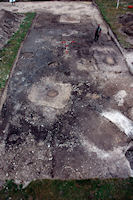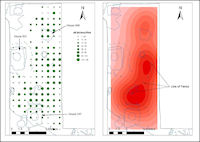
Figure 10: General shot of the midden and houses north of the Durrington Avenue, looking south
There are several areas of middening at the East Entrance. The most extensive of these areas occurred alongside seven houses covering an area of roughly 20m x 30m on a distinct slope looking down over the Durrington Avenue to the south (Fig. 10). Analysis of the animal bones (Albarella and Serjeantson 2002) suggests that the midden contained the remains of wasteful feasting episodes and the consumption of pottery and flint should be seen in these same terms. Indeed, while a variety of maintenance and building tasks clearly took place at Durrington Walls, the majority of the material from the area of the East Entrance, especially that from the midden, appears to have been associated with feasting episodes and the processing of its residues. Hence arrows were used for killing animals, scrapers were probably used for preparing hides, and retouched flakes, knives and a good proportion of the unretouched flakes may have been used for cutting meat.
The GIS analysis of the large midden context indicated that what seemed on the ground to be a uniform scatter of flint, bone and pottery was in fact three distinct concentrations (Fig. 11). More accurately, it appears that in this area there were actually three middens, each roughly 6m across. More importantly each appears to be located adjacent to a house platform. This raises a series of questions:

Figure 11: The density of worked flint from midden 593 expressed as point density (left) and kernel density (right) distributions
Stratigraphically, the middens do not underlie any of the houses and so must be either contemporary or later than them. In general, the middens seem to respect the location of the houses, suggesting that the structures were still standing or at least visible when the middens were deposited. Some of the midden material overlay the house floors, but this generally occurred down-slope from a midden and so possibly reflects the post-depositional slippage of the midden deposits over time.
Perhaps the clearest relationship between a midden and a house floor occurs with House 851 (Fig. 11). The largest of the excavated houses, this structure lay very much on the edge of the middens, and the fact that its surface was visibly cleaner than the others hints that, if there was a sequence, it remained one of the last occupied houses on the site. In this case, the edge of the midden clearly respected the stake-hole alignment that represents the wall of the house. Furthermore, an outer line of stake-holes, concentric to the house, appears to represent the line of a boundary fence that dissects the two larger middens on the site. The densities of the middens suggest that one or both of them were deposited after the fence was constructed, with much of the material being piled up against it. This chronological sequence is further supported by the fact that the stakes that formed the fence did not appear to have been driven through the midden material.
This simple relationship is revealing for a variety of reasons. Firstly, the relationship between the house, midden and fence strongly suggests that all three were contemporary. In addition, it also supports the idea that each structure was associated with its own midden. This connection between house and midden must be seen as an intentional choice. Like the Stonehenge Environs as a whole (Chan in press), Durrington Walls was a site that was heavily connected with the aggregation of widespread populations. It is also a site where people gathered to carry out many thousands of hours of communal labour in the construction of monuments. It therefore seems sensible to imagine that the feasts that clearly took place here were also communal in nature. Given all of this, it would seem to follow that the remnants of this feasting should be deposited in large communal middens. While there is the possibility that this is what occurred in other places within Durrington Walls, this clearly was not the case among the houses east of the avenue. Instead a huge quantity of animal bone, pottery and worked flint was deposited in a series of separate middens apparently linked with individual households. The extreme proximity of house and midden, and the placement of one of the middens within the boundary fence of a house serves to strengthen further the idea of household ownership.
The sense of ownership implied by this form of middening was emphasised by the extreme proximity between house and midden. When viewed as an intentional choice, one which accentuated hugely wasteful feasting episodes, the middening at Durrington Walls appears to be an act of conspicuous consumption and the active creation of a statement of the wealth and fertility of individual households. This wealth was not represented through the consumption of elaborate artefact types but rather through a massive concentration of otherwise common materials such as pottery and flint debitage.
© Internet Archaeology/Author(s) URL: http://intarch.ac.uk/journal/issue26/2/5.html
Last updated: Wed May 27 2009